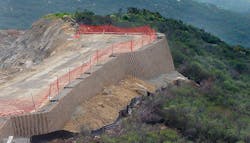Project Scope
The San Diego County Water Authority (SDCWA) imports water from the California State Water Project—a 500-mile long connection to water sources in northern California—and the Colorado River via a 200-mile-long aqueduct system. The San Diego area has been dependent on distant water resources for more than a century. Because it crosses several fault lines, the system has always been at risk due to earthquake susceptibility. As a result, an $827 million project was approved to construct the Olivenhain Dam and related water system improvements. The goal of the project co-owners, SDCWA, and Olivenhain Municipal Water District was to secure sufficient water storage capacity to sustain the region through a prolonged interruption of its imported water supply.
Power Line Access Over Difficult Terrain
Since the Olivenhain Dam would serve as a holding reservoir, San Diego Gas & Electric (SDG&E) needed to route power lines over the rugged mountainous terrain surrounding the future reservoir. Their mission was to provide power for a pump station that would fill the Olivenhain reservoir from the nearby SDCWA aqueduct. The power lines needed to be placed securely on the steep hillsides, and project owners required a solution with a natural aesthetic. SDG&E engineers selected the GEOWEB® Retaining Wall System to meet these project goals.
Site Challenges
Engineers had to overcome several site challenges for the successful completion of this project. Typical of high-tension towers in rough terrain, the footprints of the sites where the GEOWEB® walls would be placed were very tight. Accessing the remote site also created challenges for crews. The access routes to the sites were limited due to requirements that construction had to be carried out with minimal environmental impact. The power lines cross through the Elfin Forest Recreational Reserve.
Fast, Efficient Installation
The GEOWEB sections are lightweight and easily handled and installed without heavy machinery, helping to meet minimal site impact goals. Small crews quickly completed the installation, working with a tracked excavator, backhoe, and vibratory compactor.
Non-vegetated Walls Minimize Fire Fuel Concerns
Due to concerns regarding potential wildfires within the power line corridor, the GEOWEB wall faces—typically vegetated—were infilled with crushed stone and deliberately left free of vegetation. Thanks to the tan-colored, texturized fascia of the GEOWEB walls, the finished structures blend harmoniously with the natural surroundings with minimal visual impact.

